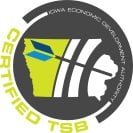Launching the exciting journey of small business growth demands more than ambition — it requires a strategic blueprint. In a recent episode of the Even Better Podcast, YCNS founder Sinikka Waugh and I discussed a guide to successfully preparing a business for growth and change. There are many ways that we can prepare ourselves for the disruption that is sure to arrive around any kind of transition, but these are the five that I have witnessed as a consultant and an organizational leader.
1. Define Your North Star:
A “North Star” transcends beyond a mission statement; it's about fostering a shared vision. Leaders should consistently point to this guiding light, ensuring alignment at all levels. This can also be thought of as generating a focal point or a goal that the team can work towards, an endpoint that proves that the journey through change has reached the goal. The North Star becomes the reference point during organizational decisions, offering a collective purpose that propels the team towards their inevitable success.
2. Be Intentional About Organizational Structure:
Invest in a strategic approach to organizational design, emphasizing the importance of distributing responsibilities effectively. Avoid the pitfalls of overburdening a few individuals; instead, encourage a collaborative approach. With a well-thought-out structure, small businesses can navigate growth seamlessly, leveraging the strengths of each team member. A well-rounded, diverse team with carefully considered and acknowledged role responsibilities will complete their work more successfully and address challenges adeptly.
3. Craft Job Descriptions People Love:
Forget the conventional approach of exhaustive lists with every meager little detail being covered again and again. Instead, try a simple approach, with broader topics that focus on the big picture. Try to focus on three key aspects per role. Through this clarity, employees gain a profound understanding of their contributions, fostering engagement and paving the way for high-performance teams. The understanding of their smaller duties under the umbrella of these larger ideas will come as they arise.
4. Document, Document, Document:
In the pursuit of small business growth, documentation can save time, money, and lots of effort. Document everything — from daily work instructions to institutional knowledge. This not only streamlines processes but also serves as an invaluable asset during expansion. An organized repository of documented procedures becomes the cornerstone for efficient operations and enables seamless onboarding; if we write down a process, we don’t have to spend any hours teaching it, just answering questions to fill in the blanks.
5. Create Communication Cadences:
Communication emerges as the heartbeat of successful businesses. I recommend implementing intentional communication patterns—establishing rhythms for different types of information. Whether through daily check-ins for tasks, quarterly business reviews for strategic discussions, or establishing a regular cadence of messaging, intentional communication builds trust. Predictable patterns enable teams to anticipate and digest information effectively and can help a team to work well together without fear of miscommunication or a lack of clarity.
As small businesses chart their course for growth, finding ways forward can be daunting. If you’re looking to get even better at managing growth, we teach these methods as a part of our Changemakers Certification Program. We ensure participants learn how to treat change as a process, not an event that we can tackle all at once. Contact us for more information on managing growth and change in your organization!








